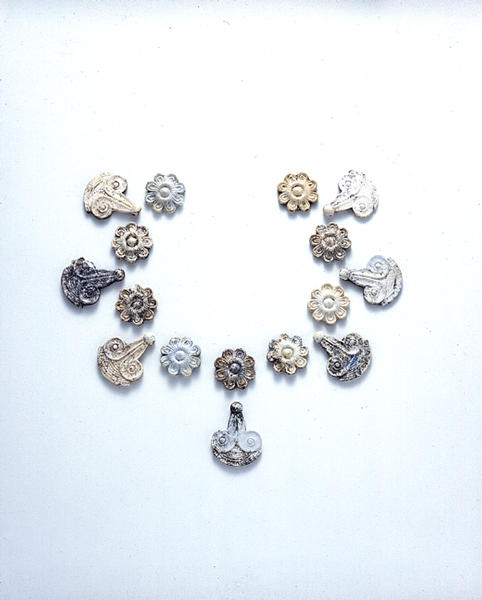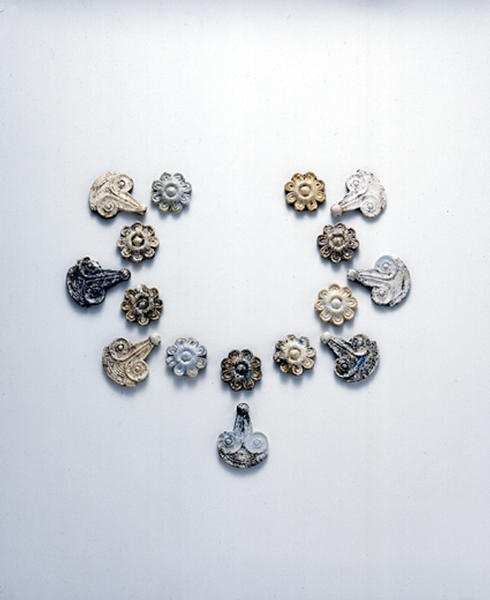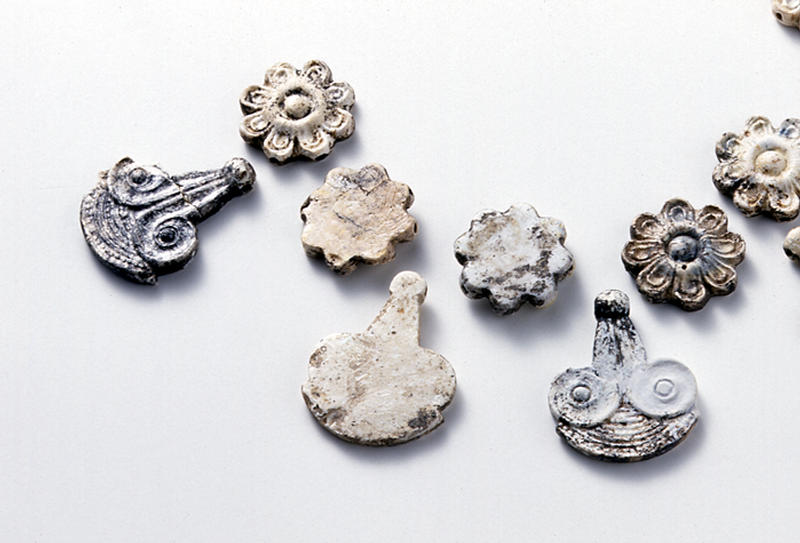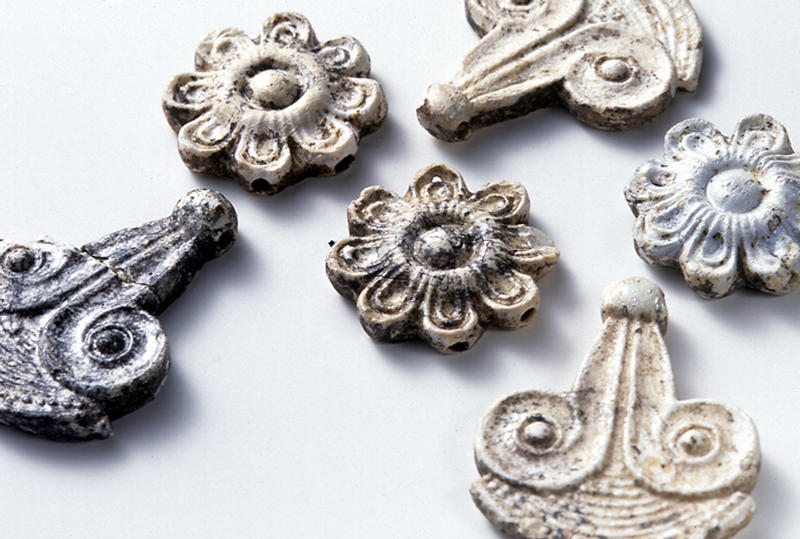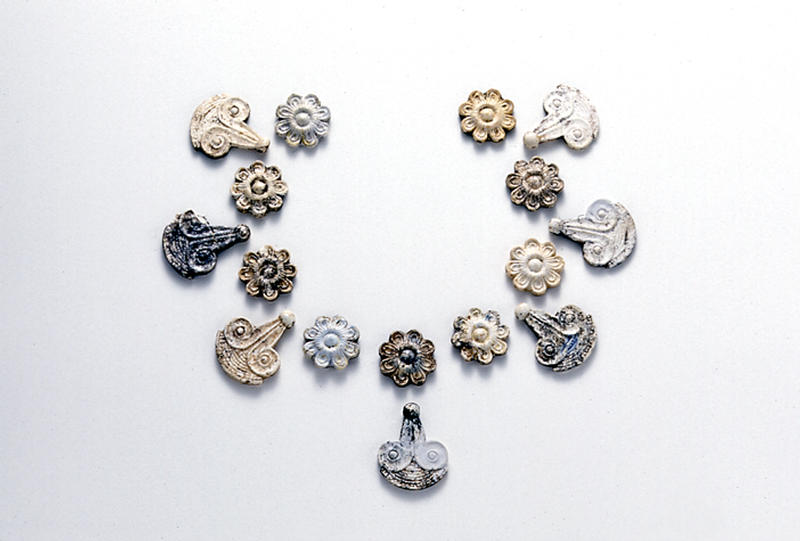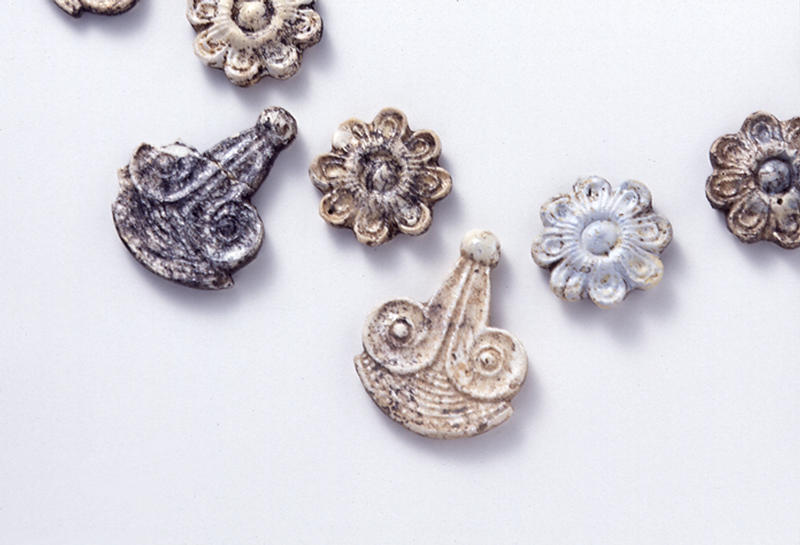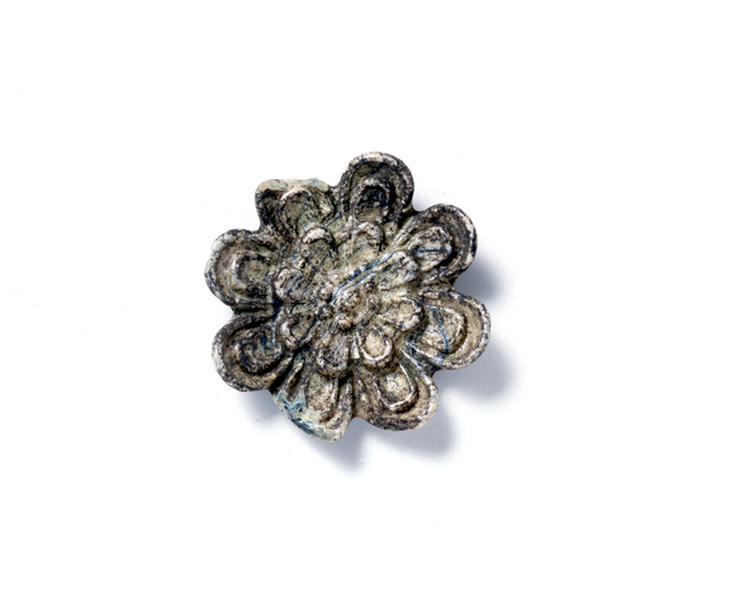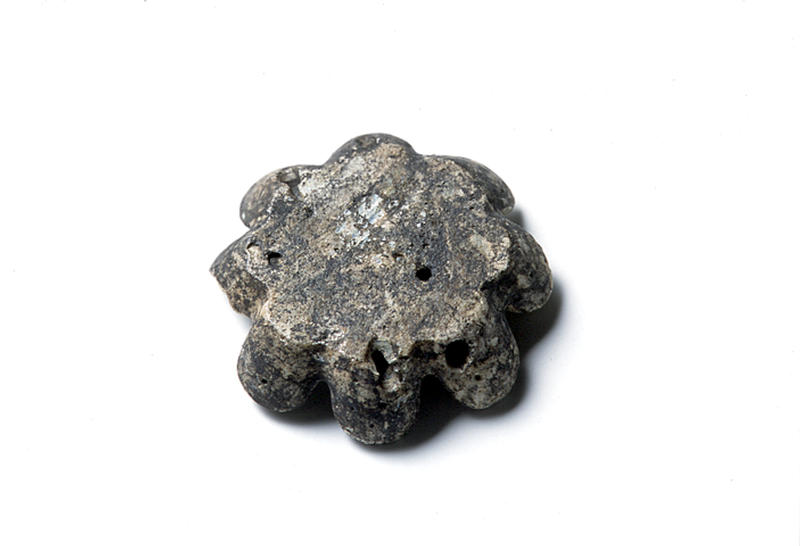植物文ペンダント、ロゼッタ文ビーズ
- エーゲ海地域
- 紀元前14-紀元前12世紀
- ガラス
- D-2.5 W-3.4
4.(ロゼッタ文ビーズ)解説
aは盛り上がった花心の周りに、二重のU字形で表現された8弁の花びらが配される。側面を2つの穴が平行に貫通している。
Bも同じく8弁であるが、二重になっており、各々の花びらの先端部が立ち上がってaよりも立体的な作りになっている。細部の表現もより精巧である。側面に2本の平行穴が貫通しており、つないで首飾りとされたのだろう。
5.(植物文ペンダント)解説
ユリの花の先端にパピルスの花のようなモティーフが重ねられたペンダントである。細部まで極めて明瞭に鋳出されており、当時の技術の高さを示している。
Catalogue Entry
a) Eight petals made up of double U-shape forms surround a raised flower center. Two parallel holes are pierced into the sides of the beads.
B) While this bead has the same 8-petal form as those at a), the petals are doubled and each flower petal has a raised tip making a more three-dimensional form. The details on this bead are more finely formed than those on a). There are two parallel holes pierced into each of the sides of the bead and it is thought to have been strung into a necklace form.
Catalogue Entry
These pendants have a papyrus flower-like motif layered on the tip of a lily flower. The details are extremely clearly cast, revealing the period's high technical levels.
解説(古代バクトリア遺宝展)
12ロゼッタ文ビーズ
前14―前12世紀
ガラス
径2.4-2.5 cm
13植物文ペンダント
前14―前12世紀
ガラス
長(平均)3.4 cm 幅(平均)2.8 cm
14ロゼッタ文飾板
前14-前12世紀
象牙
大:径2.6 cm 小:径1.4 cm
作品12、13のビーズとペンダントは、開放型の鋳型で青いガラスを鋳造し大変繊細な八花弁のロゼット文や、ユリの花の意匠を作り出している。側面に糸などを通したと思われる穴があり、複数組み合わせて首飾あるいは衣服などのアプリケ装飾としたものであろう。これらの表面は深く銀化がすすみ、ほとんど乳白色を呈しているが、部分的に本来の青色が見えている。これらはミケーネ期ギリシャで作られたものと思われる。
ガラスの製造はメソポタミアあるいはシリア・パレスチナ地域から地中海域にもたらされたものと考えられているが、最初は模造した宝石として普及した。青いガラスは古くから知られており、古代オリエント世界で珍重された深青色の貴石ラピスラズリを模したものであった。このラピスラズリの産地はバクトリア地域に含まれる北アフガニスタン・バダフシャンの山地あるいはパキスタン西部の山地で、メソポタミア、特にバビロン経由でエジプトを含む地中海世界にもたらされたと考えられる。当時の交易は物々交換を基本とした王侯間の貢物貿易であり、この古代オリエント世界の東北端からもたらされる貴石は大変貴重なものであった。前二千年紀後期にはこのガラスの代用品が盛んに作られたものと思われ、彼らの書簡では「本物のラピスラズリ」、「山でとれたラピスラズリ」が「窯で作られたラピスラズリ」と区別されるまでになっていた。北メソポタミアのヌジからは深青色で透明のガラス塊が出土しているが、このようなガラスの原料がメソポタミア、シリア・パレスチナから地中海地域にもたらされ、再び溶かされて当地で好まれた形状に成型されたのである。
また当時、シリアからは当地原産の象牙もミケーネ世界にもたらされ、様々な繊細な装飾に使われた。作品14の飾板は彼らの洗練された象牙細工の粋を示すもので、この種の装飾意匠が作品12のガラスビーズの範形となったものと想像される。
ロゼッタ文飾板
Catalogue Entry(Bac#012,013,014)
12
Rosette Beads
14th‐12th century B.C.
Glass
Dia. 2.4-2.5 cm
13
Plant-shaped Pendants
14th‐12th century B.C.
Glass
Average L. 3.4 cm, average W. 2.8 cm
14
Rosette Panels
14th‐12th century B.C.
Ivory
Dia. (Large) 2.6 cm, (Small) 1.4 cm
These beads and pendants (cat. Nos. 12, 13) were cast from blue glass in an open mold. The casting process created extremely detailed 8 petal rosette designs and lily designs. There are holes on the backs which would have been used to string a thread or such, and they were probably used in groups as applique patterns on clothing or as necklaces. The surfaces of these beads have had heavy iridescence, turning them almost completely into a milky color, with only the original blue visible in small areas. These are thought to have been made in Mycenaean period Greece.
The production of glass is thought to have been brought to the Mediterranean from either Mesopotamia or Syria-Palestine, and glass first spread as an imitation of precious stones. Blue glass has been known since ancient times, and it was made to imitate the deep blue color of lapis lazuli, treasured in the ancient Orient. Lapis-lazuli comes from the area including Bactria, from northern Afghanistan, the mountains of Badakhshan and the mountains of western Pakistan. The stone was mined in these areas and carried to Mesopotamia, and particularly via Babylon to Egypt and the Mediterranean world. The trade of this period was the basic exchange of goods as tribute between kings, and this precious stone from the far northeastern edge of the ancient Orient world was extremely highly valued. It is thought that the production of these glass copies of lapis lazuli flourished during the latter half of the 2nd millennium BC, and in their writings the lapis of the day was differentiated as either "real lapis lazuli," or "lapis lazuli from the mountains," versus "lapis lazuli from the kiln." A lump of clear, dark blue glass has been excavated in Nuzi, northern Mesopotamia, and the basic glass material would have been carried from Mesopotamia and Syria-Palestine to the Mediterranean region where it would be re-melted and formed into the desired shape.
ロゼッタ文飾板
